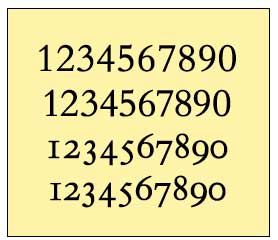|
If you’re a graphic designer and work on a Macintosh system, chances are you typically use PostScript® Type 1 fonts. If you primarily do web design, or work on a Windows machine, you probably use your share of TrueType fonts. Both formats have their advantages and disadvantages, but now there’s OpenType – offering the best of both worlds, and much more.
New Features
OpenType is a kind of superset of Type 1 and TrueType font formats, with added enhancements. It is backward-compatible with applications that support Type 1 and TrueType fonts (including design applications and printer drivers), and you can mix OpenType fonts with other font formats without a problem.
OpenType also offers some remarkable new features that require OpenType-compatible applications. (If you’re using the latest version of your operating system and applications, you may already have this capability – check with the manufacturers to be sure.) Three of these new features that are of particular benefit to designers are multi-platform support, expanded character sets and glyph substitution. Let’s look at them one by one.
Multi-platform support means that the same OpenType font will run on both Mac and Windows operating systems. This is a real convenience if your work environment uses both platforms, or if you use one system at the office and another at home.
With the consistent character encoding inherent in multi-platform support, many problems associated with transferring documents from Mac to PC (or vice-versa) will go away. If you’ve ever had apostrophes and f-ligatures turn into question marks and accented cap ‘O’s when opening a file on a different platform, you’ll be singing Open Type’s praises – and saying goodbye to the never-ending game of search and replace!

Many OpenType fonts include lining and old style numerals, with both tabular and proportional spacing.
Expanded character sets. OpenType fonts allow type designers and foundries to include many more characters than the 256 permitted in Type 1 and TrueType fonts. An OpenType font could conceivably include old style figures, true-drawn small caps, extended ligature sets, swash and alternate characters, fractions, ordinals, proportional and tabular figures, dingbats and symbols, as well as extensive foreign language characters, all in one font. As type manufacturers start to take advantage of this feature, designers will find it far easier to access these “extras,” which previously required the use of extended, alternate or expert set fonts.
Remember, although the “basic” OpenType font will work perfectly with older applications, the expanded character set feature is only accessible by software that supports OpenType.
Glyph substitution. Believe it or not, OpenType fonts have a sort of built-in “brain,” and know when to insert some of those ligatures, swashes or special characters they often come jam-packed with. For instance, some swash characters are intended only for the beginning or the end of a word, to avoid crashing into adjacent letters. When the glyph substitution feature is turned on in an OpenType-compatible application, the correct swash will be inserted automatically. If the copy is changed, the swash character will change along with it.
When many alternates are available in a font, glyph substitution can get a bit more complicated. Here’s where your brain has to take over: make sure that the characters automatically inserted by your application are the ones you want. Some manual tweaking will occasionally be necessary, although this is easy to do once you become familiar with the process.

Bembo Book Pro can substitute ligatures, swash and alternate characters and fractions at the click of a button.
Availability. A growing number of fonts are available in OpenType format. Some are new releases, while others are existing fonts that have been remanufactured. Sometimes these reissues are generously stocked with additional characters, such as alternates, swashes, small caps and old style figures, but sometimes not. If these extra characters are important to you, do your research carefully before buying to find out which additional characters are available with each font.
How do I decide?
OpenType fonts are ideal for users with cross-platform requirements, or designers who want to try out some of OpenType’s enhanced type-handling technology. Remember to check your operating system and design applications for OpenType compatibility before trying OpenType’s advanced features.
Ilene Strizver, founder of The Type Studio, is a typographic consultant, designer, writer and educator specializing in all aspects of visual communication, from the aesthetic to the technical.
Ilene formerly was the director of typeface development for International Typeface Corporation (ITC) where she developed more than 300 notable text and display typefaces. Her latest book, Type Rules! The designer’s guide to professional typography, 2nd edition, has received numerous accolades from the type and design community. She conducts Gourmet Typography workshops internationally.
Email: info@thetypestudio.com
Company Profile: The Type Studio
Company URL:
Back to Columns
page
| 


